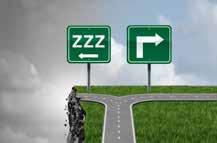
2 minute read
Traffic Safety Huddle
DROWSY DRIVING SAFETY MEETING
LENGTH 2–5 minutes
Advertisement
TO PREPARE Read the background information. Set up video of Rick and Scout.
BACKGROUND When you talk to your employees and drivers about drowsy driving, make sure they understand warning signs of being too tired to drive, and the proven methods to combat drowsiness. According to the National Safety Council, 43% of working Americans are not getting at least 7 hours of sleep nightly. Unfortunately, 1 out of 6 fatal crashes is a direct result of drowsy driving. The Bureau of Labor Statistics reports that 15% of full-time employees in the US work on shifts. Other workers are at risk of driving while sleepy as well, including those who work long hours on tedious tasks, and parents and caregivers. Head-bobbing is one serious sign of driving while too sleepy. In fact, once a driver is experiencing the head-bob, their driving is already impaired. If time permits, review the Rick and Scout video with employees after discussing other signs of drowsiness. (See link on next page.) As an employer, learn more about how fatigued employees impact your costs by visiting https://www.nsc.org/forms/real-costs-of-
fatigue-calculator
DISCUSSION We live in a GO-GO-GO world, and sometimes we don’t realize when we’ve pushed ourselves too far. Sleep seems too far off and we still have things to do. Did you know that driving drowsy is just as dangerous as driving buzzed, or even driving drunk?

What are some signs that you are too tired to drive?
Yawning and frequent blinking Missing your exit

Difficulty remembering the past few miles Drifting from your lane Hitting a rumble strip on the side or middle of the road
What happens to your ability to drive when you are too tired?
You are less able to pay attention to the road. You have slower reaction time. Your ability to make good decisions is affected.
If you think you are too tired to drive, what can you do?
Don’t drive, pull over. Get some rest. Research shows a 20-minute nap will help—at least temporarily. Drink a caffeinated beverage (like coffee or cola). Avoid driving too drowsy by planning ahead. On long trips, plan breaks at least every two hours.
OPTIONAL DISCUSSION Rick and Scout
https://mycardoeswhat.org/safety-features/drowsiness-alert/
Most drivers have driven drowsy. Ask your workers if they have experience with any of the Drowsiness Detection technologies mentioned in the video. These technologies are designed to combat drowsy driving. Let them discuss their experiences.
SUMMARY Know the signs of being too sleepy to drive, like yawning, headbobbing, and hitting rumble strips. Driving drowsy is preventable by getting enough sleep. When you are tired, pull over for a 20-minute nap or get some caffeine. Plan to stop every two hours for a break when driving long distances.







